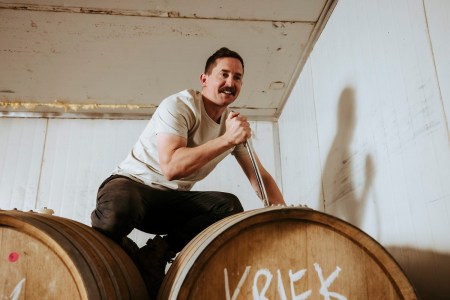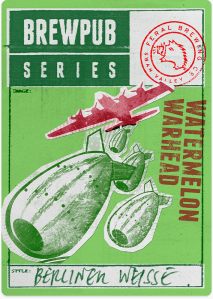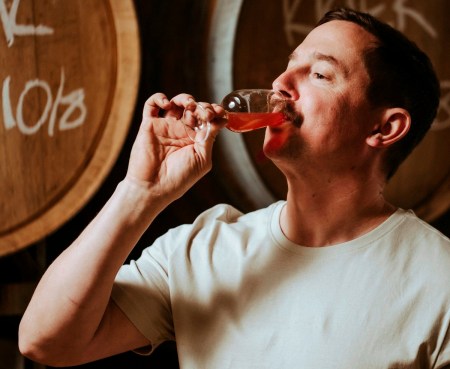
Our HomeBrewer editor caught up with Will Irving – the ex-Feral and now Found brewer – to chat about one of the most polarising of styles and have him indulge us with a recipe of his own – in both all grain and extract form – for you to try at home.
Hailing from Perth, the one brewery that springs to mind when thinking sours is Feral Brewing. Of course Feral is now not what it used to be, with the Swan Valley brewpub now the Baskerville Tavern and home to Slumdog Brewing, but it was the place where Will and Brendan Varis had a lot of fun with the style and would brew some of the best sours in the country.
Q. What was the first sour brewed at Feral?
“It was Funkie Junkie around 2011. FJ was loosely based on a geuze with one third blended with a spontaneous ferment aged in neutral barrels and two thirds a straightforward pale malt base fermented with Brett lambicus, Brett bruxellensis and pediococcus aged in old Chardonnay barrels for 18 months. Pretty ambitious for a first brew!”
Q. What advice would you give homebrewers about getting into brewing sours?
“Start off simple, do some research and have patience. If you have the space then go for gold on some long term sours and wild beers. Put them somewhere you can forget about. If 18 months is out of the question then try some quick and easy sours using lactobacillus. Just make sure your cleaning regime is up to scratch. The brewing process is the easy part. The patience that’s needed, as well as your palate on blending, that’s the hard part. Some wild yeasts and bacteria don’t like to work as hard and fast as our day-to-day strains and they can produce some absolutely terrible flavours and aromas in the short term. If the beer had Brettanomyces or pediococcus, I wouldn’t touch the barrels until six to eight months had passed, with most blends being older than 12 to 18 months. Blending barrels is another skill in itself that took a lot of time to hone in on with Brendan. Sampling beer that’s warm and un-carbonated, then knowing what it will taste like blended is tricky but rewarding. We had our own language and ratings to describe what we were tasting and how that would blend with other barrels. It was something that would evolve with each blend.”

Q. What was your favourite sour at Feral?
“Watermelon Warhead – it was loosely based on a Berliner Weisse with fresh watermelons aged in used Chardonnay barrels. Crisp, tart and refreshing with an ever evolving complexity. The initial bacteria we pitched was a White Labs Lactobacillus delbrueckii. Fast forward three years and after a lab analysis, we found another two strains of Lactobacillus and Brettanomyces in there as well. It was understandable as it was in the same storage area as our Brett beers but we assume the lacto strains came from the watermelons. It was a very cool evolution of a beer but probably un-replicable.”
Brew day
Will has shared this awesome recipe to get you started in the world of sours and in bringing the funk with Brettanomyces. He said patience is the key here and to also make sure your Brett ale is maturing well away from your other brewing gear and fermenters.

Will Irving’s Golden Brett Ale
All Grain (expected figures)
OG: 1.053
FG: 1.000
ABV: 7.0%
IBU: 24
Volume: 23 litres
Ingredients
5kg Pale malt
500g Wheat malt
40g Cascade hop pellets
6g Gypsum*
4g Calcium Chloride*
2g Whirlfloc
2g Yeast nutrient
1 sachet Fermentis S-04 ale yeast
Whitelabs Pediococcus damnosis WLP661 35ml
Whitelabs Brettanomyces lambicus WLP653 35ml
*only add minerals if your water is soft to medium profile.
Method
1. Mash all grains at 68°C for 30 minutes.
2. Mash out at 74°C, sparge and transfer to kettle.
3. Bring to the boil and add 40g Cascade hops for a 60 minute boil.
4. With 10 minutes remaining on the boil, add yeast nutrient, and whirlfloc.
5. Transfer to the fermenter and cool to 17°C, then pitch S-04 yeast only.
6. Maintain 17°C for two days, then allow to increase to 23°C.
7. On day seven, yeast off (if possible) then add Brett and Pedio.
8. Store away from your regular ferment area for eight months, testing monthly after this time.
9. The beer will let you know when it’s ready!
10. Keg and bottle as usual.
Extract with specialty grains (expected figures)
OG: 1.053
FG: 1.000
ABV: 7.0%
IBU: 24
Volume: 23 litres
Ingredients
3.75kg Pale malt extract
375g Wheat malt extract
40g Cascade hop pellets
2g Whirlfloc
2g Yeast nutrient
1 sachet Fermentis S-04 ale yeast
Whitelabs Pediococcus damnosis WLP661 35 ml
Whitelabs Brettanomyces Lambicus WLP653 35ml
Method
- Slowly dissolve the extract in seven litres of water whilst bringing to the boil.
- Once boiling add 40g Cascade hops for a 60 minute boil.
- With 10 minutes left on the boil, add yeast nutrient and whirlfloc.
- Add fresh clean cool water to a volume of 23 litres at 17°C.
- Transfer to the fermenter and cool to 17°C, then pitch S-04 yeast only.
- Maintain 17°C for two days, then allow to increase to 23°C.
- On day seven, yeast off (if possible) then add Brett and Pedio.
- Store away from your regular ferment area for eight months, testing monthly after this.
- The beer will let you know when it’s ready!
- Keg and bottle as usual.
This recipe appeared in a previous issue of Beer & Brewer. To access multiple recipes every issue, from pros and homebrewers alike, subscribe to our magazine here.

